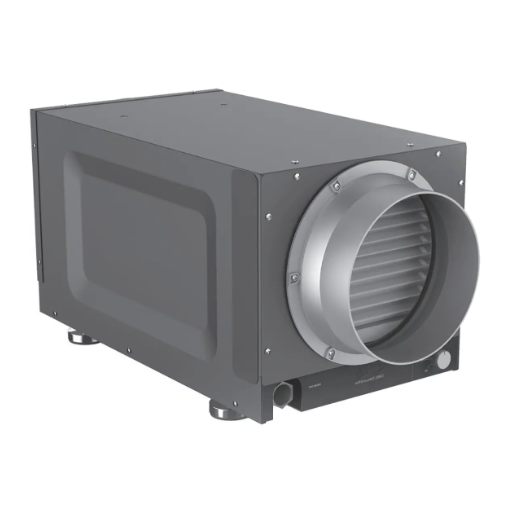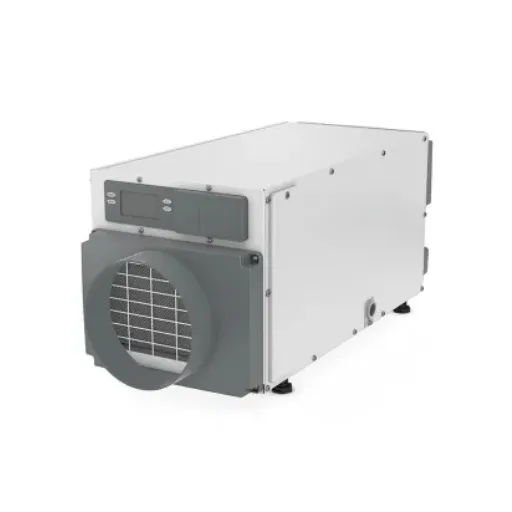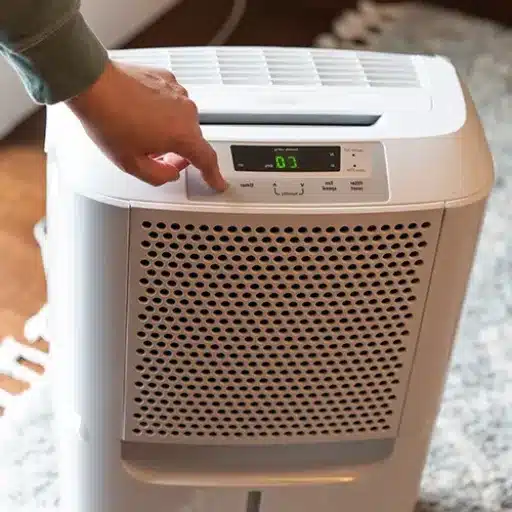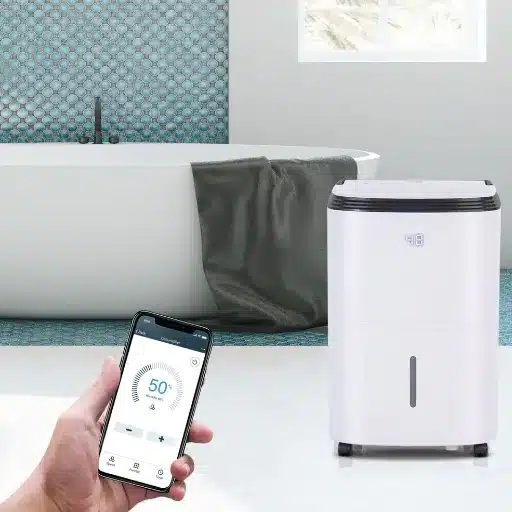Controlling indoor humidity levels is not just a matter of comfort—it’s essential for maintaining a healthy and energy-efficient home. Excess moisture can lead to problems like mold growth, structural damage, and decreased air quality, posing risks to both your property and your well-being. That’s where a whole-house dehumidifier system comes into play, providing an effective, centralized solution to regulate moisture levels in every corner of your home. This article explores the critical role of whole-home dehumidifiers, detailing the installation process and outlining their key benefits. Whether you’re looking to improve your indoor air quality or enhance the longevity of your home, understanding dehumidifier ducting and its advantages is a crucial step toward achieving a more balanced and healthier living space.
Understanding Whole-House Dehumidifiers
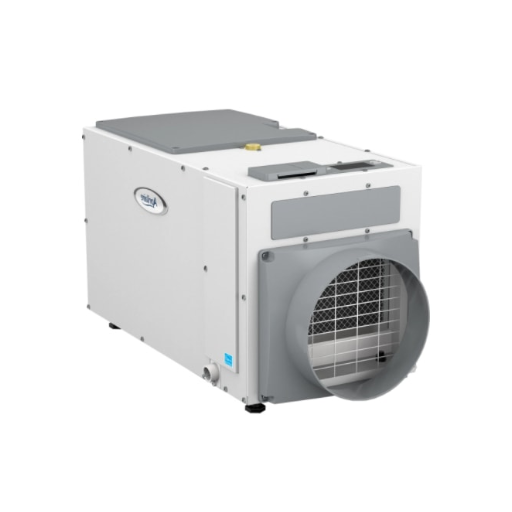
What is a Whole House Dehumidifier?
A whole-house dehumidifier is a system designed and dedicated to removing excess moisture from the air in an entire residence. Portable units can be taken from room to room or function in an individual area, but whole-house dehumidifier systems are integrated into a home’s HVAC or ductwork. They continuously work to keep the perfect humidity levels within the home, as anything less would cause discomfort, or more moisture would create issues.
Air from various parts of the home is drawn into the system; after condensation removes moisture, the drier air is released back into circulation. Most systems have controls that can be set by the homeowner to set and monitor the desired humidity level fairly easily. This style of dehumidifier prevents moisture level variation between rooms and ensures consistent air quality across the whole house, as opposed to working with an individual room.
The installation of a whole-house-type dehumidifier has its advantages. It prevents mold growth, musty smells, and heavy structural damage caused by extended periods of high humidity. Balanced humidity indoors means greater comfort, fewer allergens such as dust mites, and even better functioning of heating and cooling systems. Hence, an excellent option for those looking for complete climate control and healthier indoor living environments.
How Does a Dehumidifier Work?
A dehumidifier operates by extracting the excess moisture in the air inside a space and controlling the humidity level therein. The first step is when air is taken into the dehumidifier through an intake vent by means of a fan. This air is then passed over a set of cooling coils that are never allowed to get warm by the refrigeration system present within the dehumidifier setup. Warm, humid air, upon meeting with cold coils, has its moisture condensed into water droplets.
The water thus collected could either fill up a reservoir or be drained out through a drain hose, depending on what type of dehumidifier it is. Post moisture extraction, the now dry air passes over a set of warm coils to regain room temperature and hence gets released back into the room. This ongoing cycle helps lessen the overall humidity in a room to levels considered comfortable, alleviating the issues of discomfort caused due to moisture.
Most dehumidifiers come with a hygrometer that measures the present humidity level, allowing one to select their preferred level for maximum efficiency. Some top-shelf dehumidifiers have sensors, automatic shut-off, and energy-saving capabilities to improve ease and efficiency further. A dehumidifier that adequately controls humidity ensures that indoor environments remain intact for health, comfort, and longer-lasting structural elements.
Benefits of Using a Whole House Dehumidifier
- Improved Indoor Air Quality: A whole house dehumidifier maintains proper humidity, mediating the hazards posed by mold, mildew, dust mites-all allergens that can aggravate air quality. Research findings state that a better respiratory system and comfort can be maintained if the relative humidity level is kept between 30% and 50%.
- Energy Efficient: By drying the air inside your house, whole-house dehumidifiers lessen the burden on air conditioning systems. While dry air makes you feel cold, in turn saves energy and enables you to conserve some energy. As per the Department of Energy of the U.S., a dehumidifier used in conjunction with an air conditioner can cut cooling costs by 10 percent.
- Maintains Structural Integrity: More humidity can cause wood to rot, paint to peel, and floors to warp. Therefore, whole-house dehumidifiers prevent this kind of damage by controlling moisture levels and help extend the life of furniture, floors, and building components.
- Avoiding Condensation Troubles: Over-humidity causes condensation on the surface of windows, walls, and pipes that may turn into water damage eventually. Dehumidifiers would solve these problems, granting good looks and functionality to the surface and fixtures in the house.
- Low Maintenance and More Coverage: Unlike portable ones that dehumidify only smaller areas, whole-house dehumidifiers are integrated with the HVAC system, thus providing humidity control for all the rooms. They require less emptying of water reservoirs due to the direct drainage systems of whole-house dehumidifiers.
Importance of Ducting in Dehumidifier Systems
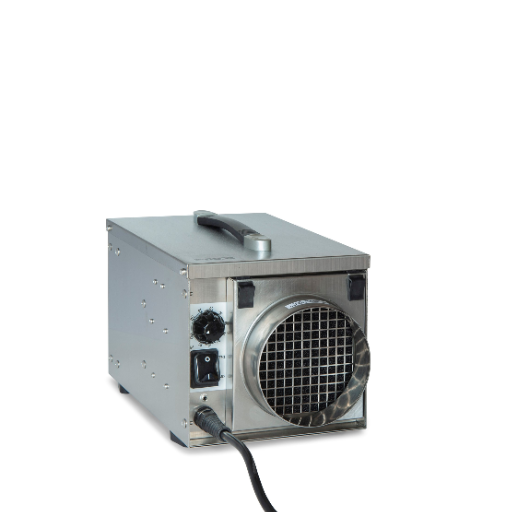
How Ducting Enhances Air Quality
Ducting has a very significant role in keeping the dehumidifier system running smoothly to maintain the air quality in its best condition. The ductwork seamlessly ties the dehumidifier to the HVAC system in the home and provides means for the uniform distribution of conditioned air-that is dehumidified all rooms. With this integration, no intensified humidity or airborne contaminants will be inhibitors, such as mold spores and dust mites, which require high-moisture environments, in any single room. Also, as air moves into and through the HVAC system, unwanted pollutants get filtered out so that the system itself greatly banks on indoor air being cleaner.
The contemporary design of ducting makes a more positive impact on dehumidification systems by providing efficient airflow. Ducts should be sealed and insulated, minimizing air leakage so the dehumidifier system is in full operation and working at top capacity without wasting energy. Industry research shows that leaking ducts can waste up to about 30% of airflow, thereby decreasing the efficiency of the system and increasing the consumption of energy. An air well-conditioned by ducts will, together with state-of-the-art dehumidifiers, work against energy wastage and, with the removal of moisture and contaminants, be applied throughout the household, including areas that are difficult to reach.
The incorporation of advanced filtration systems within the ducts ensures enhanced air purification. Certain state-of-the-art systems use HEPA (High-Efficiency Particulate Air) filtration or UV-light sterilization against microscopic allergens, bacteria, and pathogens. Such improvements would not just really improve the indoor air quality, but would also stop the circulation of harmful particles through the house. With regular duct cleaning and inspections, indoor spaces can be kept free from humidity-related instances like mildew or allergies while eliminating concerns over respiratory health problems. Thus, ducting is one of the vital components in maximizing the efficacy and health attitude of any dehumidifier system.
Role of Return Ducts in Dehumidification
Return ducts are crucial for optimizing the performance and efficiency of any dehumidification system through the effective circulation of indoor air. In effect, these ducts pull air from various spaces within a building and feed it back into the dehumidifier for processing. Thus, moist air is constantly being supplied to the system, which allows for efficient removal of the excess moisture. Because of this, their proper design and size allow the placement of air-balance points, preventing stagnant air zones, or localized areas of high humidity that could harbor microbial growth.
Modern dehumidification systems feature improved duct materials and designs that reduce common airflow losses. Research indicates that poorly sealed or inadequately designed return ducts can cause airflow inefficiency of up to 20-30%. These losses therefore lessen the capability of the system in maintaining the desired humidity levels and increase its consumption of energy due to longer run cycles.
Meanwhile, monitoring advancements have evolved, allowing the embedding of sensors inside the return ducts to continuously check on actual humidity and temperature conditions. This information is used for smart adjustments of system performance to maximize energy efficiency and comfort. Hence, by employing well-engineered and well-maintained return ducts, building operators will exploit the full potential of dehumidification systems, ensuring good indoor air quality and energy efficiency.
Integration with HVAC Systems
When well-integrated with HVAC (Heating, Ventilation, and Air Conditioning) systems, dehumidification systems stay perfectly balanced in environmental control and energy efficiency. Thus, modern HVAC environments require impeccable coordination of equipment-air handling units, compressors, dampers, and dehumidifiers that operate in tandem to keep temperature and humidity levels ideal. Being highly adaptive with advanced control logic and automation technology, the system can vary its operation based on real-time environmental.
Furthermore, the level of integration is further enhanced through the deployment of BMSs. The BMS integrates the entire HVAC system, including the dehumidifiers, onto a centralized platform that allows the facility manager full-spectrum monitoring and operational control. Airflow rates, humidity levels, temperature changes, and even energy consumption data are collected and monitored to predict HVAC system performance changes, thus allowing corrective measures to be taken on time, enhancing or sustaining system uptime and lifetime. For instance, the BMS may detect unusual humidity levels in a particular zone and either initiate precise corrective actions or alert maintenance personnel to investigate.
Furthermore, the integration process safeguards that the installation meets all industry guidelines, such as those issued by ASHRAE, to be safe, reliable, and efficient. For design, however, it must take into consideration building load requirements, regional climatic conditions, and occupant density. Plus, integration of energy recovery ventilators (ERVs) or heat recovery ventilators (HRVs) with the HVAC system paves the way for energy recovery and reuse. Hence, the total energy consumption incurred during dehumidification is drastically reduced. Equipped with such sophisticated integration methods, modern HVAC systems yield the best indoor air quality, occupant comfort, and energy conservation.
Installation Process for Whole-House Dehumidifiers
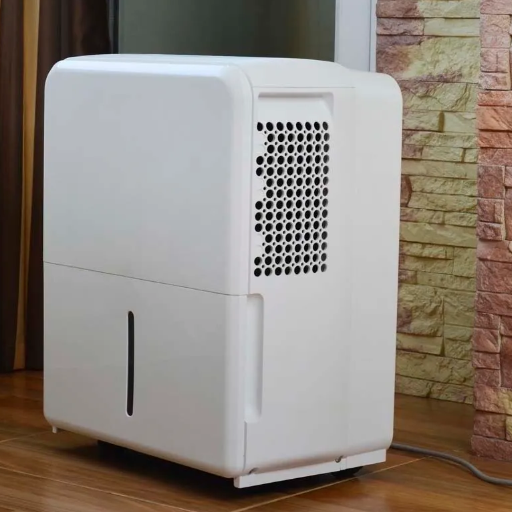
Step-by-Step Dehumidifier Installation Process
- Evaluate System Requirements: Begin by assessing the installed HVAC system and identifying the particular dehumidification needs based on house size, climate zone, and moisture content. Professionals use instruments like hygrometers to determine indoor humidity within an advisable range (30%-50%).
- Select the Appropriate Unit: Choose a whole-house dehumidifier compatible with the installed HVAC system, considering capacity (measured in pints/day), energy ratings, and airflow requirements. Also, ensure that the selected unit meets efficiency standards for highest-grade performance, such as those laid down by ENERGY STAR.
- Identify Installation Location: The installation of the dehumidifier should be situated centrally, say in the return duct of the HVAC system or in a mechanical room, whereby access is granted for future maintenance. Verify that ample space is available for ventilation purposes, and also check with local building codes for clearance and safety requirements.
- Connect to the HVAC System: Attach the dehumidifier within the existing duct system, either on the return side or supply side, depending on what the unit specifies. Ensure that all duct joins are sealed with UL-listed mastic or foil tape to prevent leakage of air and deterioration of system efficiency. If applicable, insulated ducts should be utilized to prevent heat gain or loss.
- Configure the Drainage System: It is necessary to set up an effective drainage system that provides for the removal of the condensate formed during the dehumidification process. Should the dehumidifier connect to a condensate pump or drain by gravity, local plumbing codes need to be adhered to. Rigorous checking of any obstruction in the drains is necessary, as it slants downward to avoid water backing.
- Provide Wiring and Electrical Connections: Connect the dehumidifier to a power supply safely, observing the guidelines set by the manufacturer, which usually require the unit to be connected to a dedicated circuit. Employ a circuit breaker or fuse, Admissible for protecting the circuit against overloads. Enter into meticulous tests of the electrical connections to prevail against safety hazards.
- Calibrate Control System: Install a compatible humidistat or dehumidifier into the main HVAC control system for automated operation. Set the desired humidity level according to regional and indoor comfort recommendations.
- Test the System: Upon the completion of installation, run the dehumidifier with the HVAC system to confirm it works. Observe the system’s airflow, drainage, and humidity levels to affirm that everything is functioning well. Take action to resolve any leaks, electrical, or operational faults immediately.
- Homeowner Instruction: Give the homeowner an outline that explains the proper dehumidifier operation, schedule, and basic troubleshooting. Guide changing filters and system maintenance procedures to allow for eventual service efficiency and reliability.
Hence, by carefully following these precise steps, the installation process will ensure a proper integration, high-performance level, and long service life of whole-house dehumidifiers incorporated within present-day HVAC systems.
Choosing the Right Location for Your Dehumidifier
An appropriate placement of the dehumidifier would be largely responsible for its working and efficiency. Usually, it is placed centrally with unobstructed air passages so that the humidity can be controlled evenly in the area. Basements, crawl spaces, or utility rooms are typical locations for placement since these spaces most commonly experience moisture buildup.
Make sure there are no walls, pieces of furniture, or any obstructions for the dehumidifier to be placed on, as air must circulate freely around the intake and exhaust vents. In case of whole-house dehumidification through HVAC systems, the plant would have to be installed near the return air duct for the best results. In addition, the location must have options for draining—such as near a floor drain or compatible condensate pump—so that the constant water removal can be serviced without any issues.
Also, consider the temperature and humidity levels present in the selected location. Some dehumidifiers may diminish in performance when used under lower temperatures, which would call for antifreeze or special low-temperature models for use in colder areas. Meditating well upon the layout, airflow necessities, and ambient considerations of your abode will lead to the most effective and energy-saving dehumidification of the home.
Proper Sizing and Configuration of Ducts
Proper sizing and configuration of a ductwork system are some of the most important considerations for creating absolutely ideal air distribution, preventing any energy wastage, and equally guaranteeing system efficiency. Duct sizing, in particular, should be based on the amount of airflow in CFM (Cubic Feet per Minute) necessary to suit the space requirements. Relevant standards, such as ACCA Manual D, have laid down detailed procedures and instructions for choosing appropriate duct sizes and the location of the system.
Important factors affecting the selection of duct sizes include static pressure, duct material, and the length of duct runs. Poorly sized ducting may cause low air velocities, uneven temperature distributions, or high energy usage, to name a few inefficiencies. Further, proper arrangement and configuration of the ducts for good air distribution with very little turbulence are also important. This includes placing bends, elbows, and transitions in such a manner as to avoid unnecessary obstruction to airflow.
Good duct sealing by using mastic or UL 181-approved tapes must be applied to minimize infiltration. Air leakage can contribute to as much as 30% energy loss in a poorly sealed system. Also, duct insulation in all unconditioned spaces prevents temperature loss, thus keeping the air delivery temperature from deviating from that intended.
Following these rules and regularly keeping the ductwork in check for problems such as obstruction and leaks will immensely help the homeowner and technician boost the air distribution efficiency, lower energy bills, and ensure the everlasting performance of the HVAC.
Common Mistakes to Avoid in Dehumidifier Installation
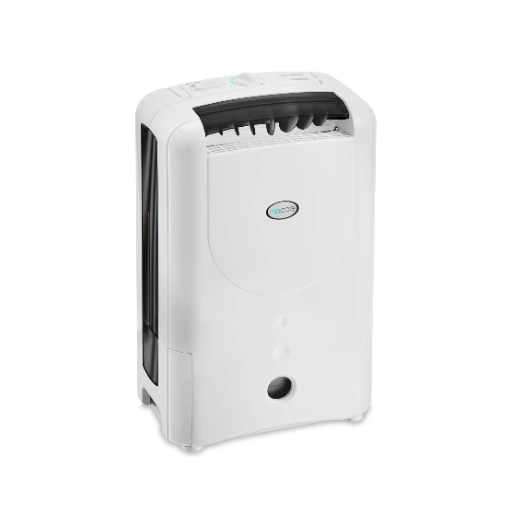
Incorrect Duct Sizing Issues
Incorrect duct sizing, being a very common problem, can affect the performance of a dehumidifier and the overall HVAC system. When ducts are undersized, they impair flow, causing excessive static pressure in the system. Increased static pressure causes the dehumidifier or the HVAC fan motor to consume more energy and work harder, as they try to compensate for the reduced flow. Too large ducts, on the other hand, would mean low air velocities and therefore less capacity of the system to appropriately circulate air and maintain consistent humidity levels throughout the space.
Improper duct sizing can also cause uneven distribution of air, with some areas getting too much air and others receiving too little air. Comfort is compromised in both scenarios, perhaps also leading to moisture buildup and mold in under-ventilated places. Research in building performance has shown that such problems can reduce system efficiency by up to 30%, reinforcing the importance of doing the right calculations during installations.
To avoid all these, technicians must now do a thorough Manual D or equivalent load calculation to come up with duct dimensions that will suit building size, air volume requirements, and system specifications. This will ensure balanced air flow, energy efficiency, and the longevity of the system. Proper ductwork design will keep the dehumidifiers and HVAC units highly functional and reliable.
Improper Sealing and Its Effects
In ductwork, improper sealing is one of the most common yet overlooked problems during HVAC installation. Doors, seams, or joints, if not sufficiently sealed, suffer substantial air leakage. According to industry data, duct leakage can lead to as much as 30% loss of conditioned air between residential and commercial buildings, hence compromising energy efficiency. More leakage means higher pressure on HVAC systems to perform their functions, along with greater electricity bills and a discomforting ambiance within the building. Poor sealing of ducts reduces system performance as they allow contaminants from the outside, including dust, pollen, or moisture, to readily penetrate the ducts, thereby degrading the quality of air inside over time.
It is also worth considering the dents made on system durability and maintenance costs. The leaking ducts force the HVAC to work harder at temperature maintenance, which consequently fast-tracks the wear and tear of vital components such as the blower motor and compressor. The harsher passage of the equipment considerably shortens its lifespan and, thus, triggers frequent maintenance visits that tend to be costly. Moreover, poor sealing obstructs airflow balance, causing uneven temperature distribution inside the building. Some spots are overheated or overcooled, while others are just the very thing that indicates the absence of system uniformity.
These programs recognize that duct leakage should be minimized as far as possible for the highest energy performance. Therefore, proper sealing should take place using techniques such as UL-rated duct mastic or modern aerosol sealing. Testing protocols such as duct leakage tests and commissioning procedures provide quantifiable assurance that the sealing is within astoundingly acceptable bounds. Addressing improper sealing issues upon installation and through maintenance is a big step forward to ensuring system efficiency, longevity, and a healthy indoor environment.
Neglecting Airflow Considerations
Ignoring airflow considerations in HVAC systems cascades into a downhill scenario involving loss of efficiency, occupant discomfort, and system strain. Airflow is necessary to distribute conditioned air evenly within a building and maintain the HVAC system and its components within their designed working. When airflow is not considered, pressure imbalances between spaces are created along with uneven temperature distribution and an ever-falling indoor air quality.
The common static pressure is used to measure airflow resistance in air ducts and equipment. High static pressures can indicate blockage, duct system design inadequacies, or equipment sizing problems, all of which consume more energy and stress mechanical parts. It is widely reported that even slight deviations from ideal flow rates have their efficiency down by great amounts-namely, 20% in extreme cases.
But to make matters worse, poor airflow exacerbates humidity control problems. These disturbances can induce mold growth, reducing the system’s dehumidification efficiency and, thereby, presenting health hazards and damage to building integrity. To avoid these, it is important to always consider a total airflow management concept, including proper duct design, regular maintenance of air filters, and performance measurements with, for example, anemometers or manometers.
By paying proper attention to all aspects of airflow in design as well as in operation, an HVAC system can provide for efficient operation and energy conservation, with a profitable indoor environment. Proactive testing and balancing procedures, together with guidance from industry standards (e.g., ASHRAE 62.1 for Ventilation), lay the groundwork for the long-term viability of the system and safety of the occupants.
Maintenance Tips for Whole-House Dehumidifiers
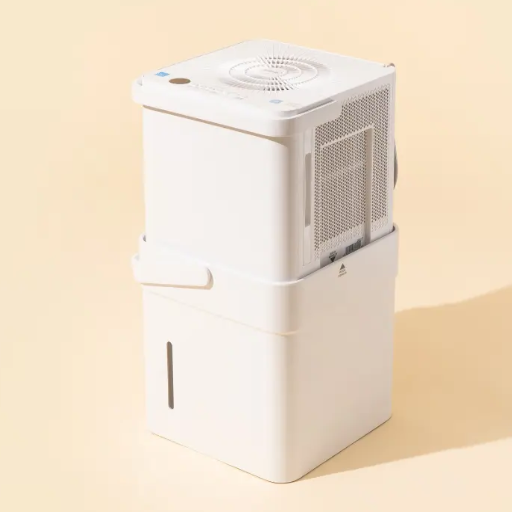
Routine Cleaning Guidelines
An effective routine cleaning is essential to the functioning, life span, and performance of a whole-house dehumidifier. Start by disconnecting its power source, for safety purposes, before undertaking maintenance. Inspect and clean or replace the air filter every one to three months according to the manufacturer’s recommendations and depending on how often the unit is used. Filters tend to collect dust and debris that can restrict airflow and thus thinner the effectiveness of the system.
Next, inspect and clean the condensate drain lines to keep them free of blockage caused by the buildup of mold or minerals. Flush these lines with warm water mixed with a mild detergent or vinegar to clear any problems and to prevent backups from forming. Also, wipe the inside parts and coils of the unit with a soft cloth to remove any dust accumulation and help maintain heat exchange efficiency.
For increased performance, check fan blades and motor parts for wear or dirt. Lubricate any moving parts as required and permitted by the manufacturer’s specifications. Ensure the humidity sensor is working properly by verifying its readings with those of an accurate hygrometer.
Always refer back to the manual for your unit with regard to cleaning and maintenance checklists and the intervals for doing so, making sure you abide by the manufacturer-specified instructions. Such measures would keep the unit running in top shape and avoid costly repairs, hence providing maximum return over time.
Filter Replacement Schedules
Proper adherence in filter replacement schedules from time to time can make the air handling or purifying unit go all the way with efficiently. Filters being critical constituents, these systems trap dust particles, allergens, and microbial contaminants. In time, these filters get clogged with debris that reduces airflow and strains the motor of the unit. The usual replacement time is prescribed by manufacturers, depending on the type of filter, usage conditions, and its efficiency rating. For instance, regular fiberglass filters need to be changed every 30 days, based on use; however, HEPA filters, depending on the design of the unit, may have a life span of up to 6 months in normal operation.
It is also environment-dependent; such dictates filter replacement schedules. Units operating in polluted atmospheres, such as in urban centers or industrial zones, would need to be changed more often. Similarly, we have a seasonal influence where spring pollen count acts against timely maintenance. For home units, further considerations should include pets, as pet hair and dander may be piled up fast enough to weaken filter integrity. Also, do keep an eye on the filter condition; many contemporary systems now include indicator lights or integrated monitor-software-based alerts on when to replace the filters, thus minimizing speculation and enhancing system efficiency.
Neglecting the timely replacement of filters may cause a gradual deterioration in system performance. Blocking of filters leads to greater energy consumption as the unit tries harder to maintain the airflow; it may also cause wear that shortens the equipment’s life. Neglected filters can adversely affect indoor air quality, thus aggravating occupants’ respiratory disorders. Taking an early initiative ensures the system works at its best with replacement and avoids some energy-based expenses to fix large-scale issues. Always replace filters using manufacturer-approved parts to keep the warranty intact and meet the intended performance specifications.
References
-
Investigation of Energy Impacts of Ducted Dehumidifier Duct – A detailed study on the energy impacts of ducted dehumidifiers, discussing their design and performance.
-
Energy and Latent Performance Impacts from Four Different Dehumidifiers – Research focusing on the performance of ducted and unducted dehumidifiers in residential settings.
-
Development of an Integrated Residential Heating and Dehumidification System – A project report on integrating dehumidification with residential heating systems.
Frequently Asked Questions (FAQ)
Q: What are the benefits of using whole-home dehumidifier ducting?
A: Using whole-home dehumidifier ducting helps maintain balanced humidity levels in your home, which can enhance comfort and indoor air quality. It efficiently distributes dehumidified air throughout your living spaces, reducing the risk of mold growth and damage to your home caused by excess moisture.
Q: How do I install a whole-house dehumidifier with existing HVAC?
A: To install a whole-house dehumidifier with existing HVAC, you can connect the dehumidifier to your ductwork. This allows it to work seamlessly with your air handler, ensuring that dehumidified air is circulated throughout your home. It’s recommended to consult with an HVAC professional for proper installation to avoid any issues.
Q: What should I consider regarding the dehumidifier cost for my home?
A: The dehumidifier cost can vary based on the model and capacity. High-capacity dehumidifiers are generally more expensive but are essential in humid climates. Additionally, consider installation costs, energy efficiency, and the long-term savings on your energy bills when selecting a dehumidifier.
Q: How does a whole-home dehumidifier improve indoor air quality?
A: A whole-home dehumidifier improves indoor air quality by removing excess moisture from the air, which helps prevent mold and mildew. This leads to cleaner air being circulated back into your home, enhancing comfort and promoting a healthier living environment.
Q: Can I connect a dehumidifier to my existing ductwork?
A: Yes, you can connect a dehumidifier to your existing ductwork. This integration allows the dehumidifier to utilize the existing HVAC return system to effectively distribute dehumidified air throughout your home, improving overall humidity control.
Q: What is the role of a thermostat in whole-home dehumidifier systems?
A: The thermostat plays a crucial role in whole-home dehumidifier systems by regulating when the dehumidifier turns on and off. This ensures that humidity levels in your home remain within a comfortable range, preventing over-drying and maintaining an optimal indoor climate.
Q: What are the differences between consumer-grade dehumidifiers and whole-home systems?
A: Consumer-grade dehumidifiers are typically smaller and designed for single rooms, while whole-home systems are ducted and can effectively manage humidity levels across an entire home. Whole home systems are more efficient in humid climates and can integrate seamlessly with existing HVAC systems.
Q: How does fresh air ventilation impact humidity control?
A: Fresh air ventilation can help regulate indoor humidity levels by introducing outdoor air into your home. However, in humid climates, it’s essential to pair fresh air ventilation with a whole-home dehumidifier to ensure that the incoming air does not raise humidity levels beyond comfort.
Q: What items in my home can be affected by high humidity levels?
A: High humidity levels can affect a variety of items in your home, including furniture, electronics, and personal belongings. Excess moisture can lead to mold growth, warp wood, and damage fabrics, making it crucial to maintain balanced humidity with a whole-home dehumidifier system.

